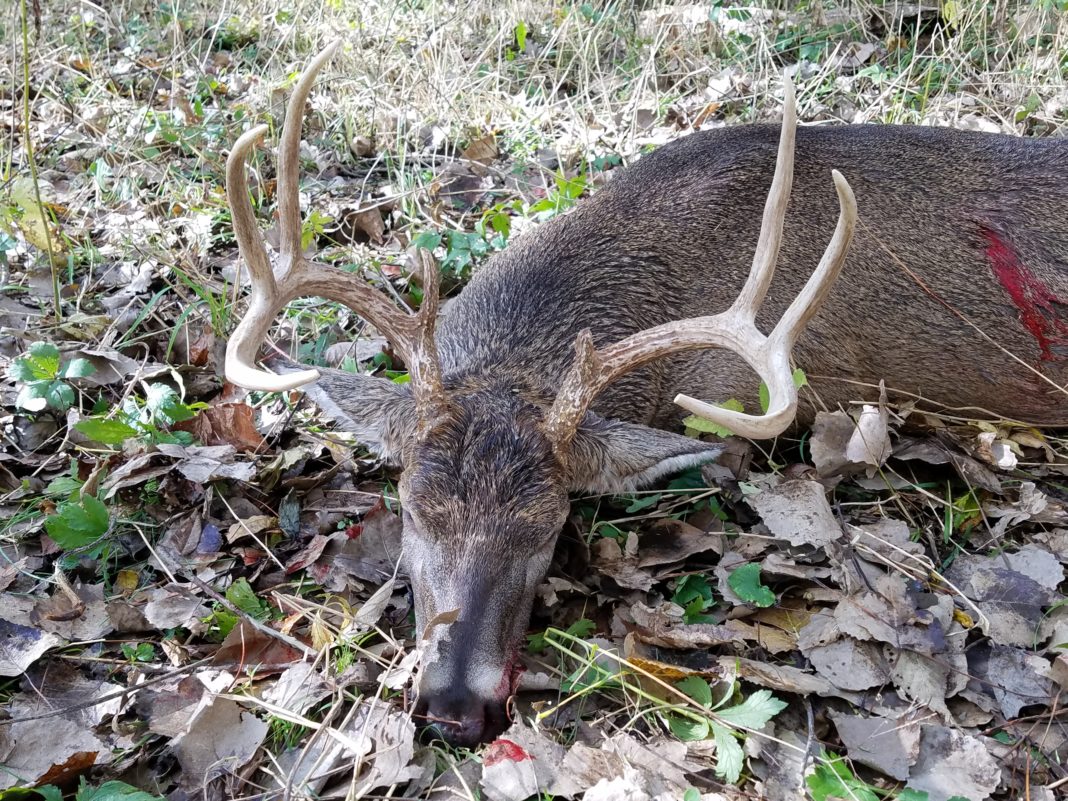Rutting activity turns on around the first day of November, give or take or a day or two. Hunters plan their work vacation to coincide with the whitetail rut. For a few days each year, grown men and women choose to spend entire days sitting in a tree, waiting for a shot at a mature buck.
For the most part, temperatures during the rut are mild. Bucks are on the prowl searching for does, having little regards for their own safety. No wonder this is when most big bucks are killed. However, late in the season is a close second for the best opportunity at killing a mature buck.
Late in the season with just a few weeks remaining to fill a tag, many hunters have decided to call it quits for the year. Combine the hunters who have put their bows up for the year and are waiting for the next season to open. During this time of the season there are very few hunters still after it compared to just a few weeks earlier. With the lack of hunting pressure, whitetails will get back in a predictable routine.
Deer will begin to move early in the evening later in the season. During this time of the season most deer will be done feeding and back in their beds by the time the sun rises, making a morning hunt very tough. I recommend forgoing the morning hunt, and waiting until the afternoon before heading to the woods.
The deer that arrive first at the food sources I hunt over are often mature bucks that did the majority of the breeding during the rut. Bucks lose up to 30-percent of their body fat during the rut chasing does, breeding and fighting other bucks. This takes a toll on their bodies, and in order to survive the winter, they have to put weight back on.
Late in the season, grain fields have been harvested already and any remaining grain on the ground has already been ate. To be able to provide food for the deer and turkeys throughout the winter, I plant a few small food plots. I concentrate on planting brassicas like sugar beets, turnips and rape. The starches in these plants turn to sugars after the first hard frost. Deer will devour these plants from the leafy forage to include the sweet bulbs.
When you plant food plots to hunt over late season, take into consideration where your stand or blind will be. You want to be close enough for a good shot opportunity. Plots do not have to be very big. I have taken nice bucks off of plots smaller than one-quarter acre.
Try to plant your food plots in an hour glass shape. This will cause the deer to have to funnel through a small opening, hopefully offering a close shot. Just make sure your stand or blind is in a position so you have a shot as the deer pass through the narrow opening.
Another thing to take into consideration before you plant your food plot is how you will get to and from your stand without being noticed. There is not a lot of cover to conceal a person this time of the year. Because of this, you will want your plot in an area that you can travel to undetected. For example, one of my favorite stands I hunt from, I walk in a dry creek bed with high banks. This prevents the deer from seeing me coming and going.
Not all hunters have food plots, or maybe the deer have cleaned them out. A hunter can still find what the deer are feeding on if there is fresh snow on the ground which there normally is late in the season. Just follow the deer tracks through the snow.
Locust trees drops large bean pods. Deer could care less about them in the fall, but in the winter when food is slim, deer love them. It is common to see where whitetails have dug and pawed through the snow to get down to the pods.
I have even seen oak trees holding acorns and apple trees still bearing fruit late in this season, but this is not common. If you can find such trees, you have found a goldmine. But, when the mast starts to drop, a hunter will not have much time to take advantage of it before the deer and other wildlife eat it all up.
To be a successful hunter late in the season, you have to be warm, but still be able to draw your bow back. Wool is the best choice. It can be a bit expensive, but it blocks the wind, is very warm, and even insulates when wet. Also, it is quiet so you don’t have to worry about rubbing up against something and spooking deer.
Because my hands and toes easily succumb to the cold, I always have hand and toe warmers at the ready.
Scouting and determination are the two keys to late season success. Know what the deer are feeding on, and hang a stand or erect a blind to arrow an unsuspecting buck. Finally, be patient and the deer will come.



















![The Best Deer Camp Chili [VIDEO] Deer Chili Ingredients, Tomatoes, Chili Spices](/wp-content/uploads/2015/10/Deer-Chili-Deer-Camp-Recipe-218x150.jpg)
![How to Call Elk Early in the Season [VIDEO]](/wp-content/uploads/2016/08/byers003-218x150.jpg)




![Idiots Disturb Hunter: How Would You Have Handled It? [VIDEO]](/wp-content/uploads/2015/10/DSC00110-e1474487693878-100x70.jpg)
![Albino Buck Shocked to Shed His Antlers [VIDEO]](/wp-content/uploads/2015/10/AlbinoDeer-100x70.jpg)